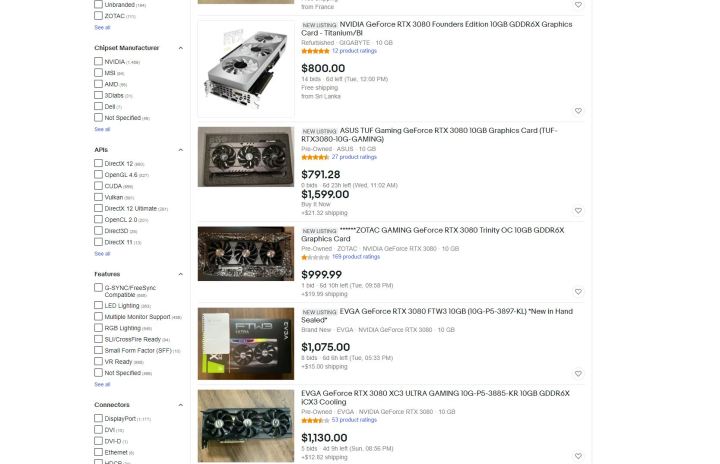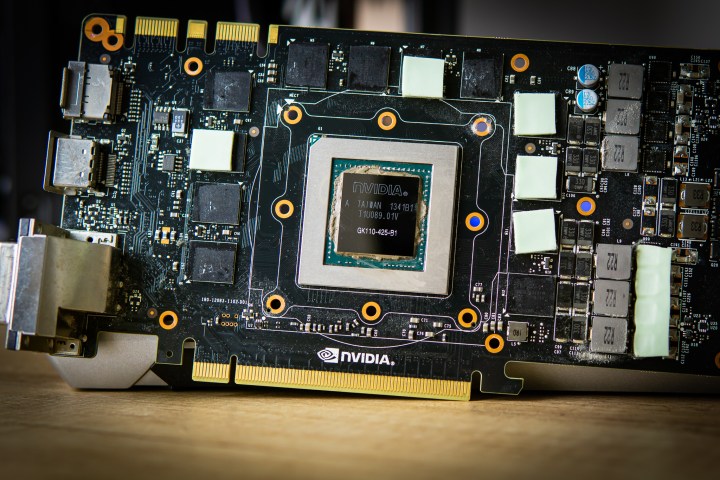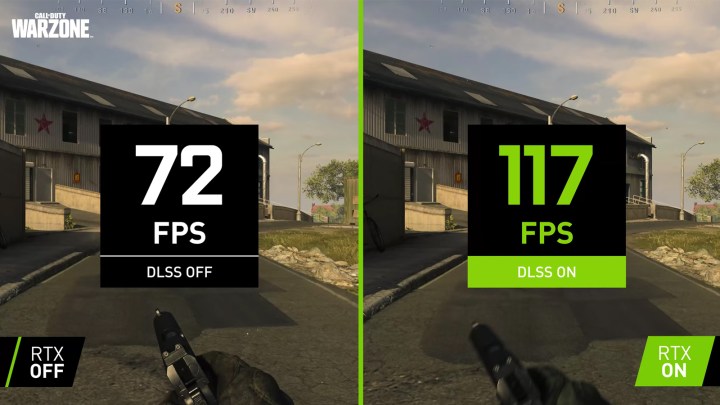There’s no denying 2021 was a tough year for GPUs, and for PC enthusiasts as a whole. We all hoped the GPU shortage would be over before the end of the year, but at the start of 2022, the situation hasn’t improved. There’s a lot to get excited about from graphics cards in 2022, though.
From the entrance of a third major competitor to the cautiously optimistic signs for increased supply, 2022 is shaping up to be an inflection point. Now that the ball has dropped and our calendars have reset, here’s what to expect from graphics cards this year.
Intel Arc Alchemist GPUs

Perhaps the most exciting GPU news for 2022 is Intel’s Arc Alchemist graphics cards. Intel makes a lot of GPUs, but Arc Alchemist marks the first time the company is designing a slot-in desktop GPU that’s focused on gaming.
Rumors suggested Intel would launch the cards at CES, which is kind of true. Intel announced that Arc Alchemist is in over 50 desktops and laptops “coming soon” at CES, but the company didn’t provide details on what cards are in the range, when they’ll arrive, or how much they’ll cost. For now, we know about a few laptops — such as the Alienware X17 — with an Arc GPU, but no other details besides that.
The rumor mill says that the flagship card from the range will perform around the level of an RTX 3070, but I’m waiting until Intel shares more. Intel has already shared some information about its XeSS upscaling feature that will be included with these graphics cards. It functions similarly to Nvidia’s Deep Learning Super Sampling (DLSS), and Intel has announced that Hitman 3, The Riftbreaker, and Death Stranding: Director’s Cut will support the feature at launch.
It’s been too long that the GPU market has been wrapped up in the AMD and Nvidia rivalry, so I’m looking forward to what Intel can do with Arc Alchemist. XeSS looks disruptive enough, and as long as the cards perform like rumors suggest they will, we’ll have a third competitor in the ring. That said, we’re already in the launch window Intel announced for Arc Alchemist, and we still know very little about the cards.
New mobile GPUs from AMD and Nvidia

Nvidia recently launched a 12GB variant of the RTX 2060 Super, and at CES, Nvidia and AMD came with new desktop announcements. AMD brought the $199 RX 6500 XT, and Nvidia showed off the $249 RTX 3050 and RTX 3090 Ti. Nvidia also quietly launched a 12GB variant of the RTX 3080, which was absent from its CES keynote.
That’s it for desktop announcements right now. For the first half of the year, Nvidia and AMD are focused on mobile graphics. AMD brought eight new mobile GPU designs to CES, including the new RX 6000S cards. These cards are a counter to Nvidia’s Max-Q offerings, focusing on performance per watt instead of raw performance.
Nvidia only showed off two new mobile GPUs, but they’re good ones. The RTX 3080 Ti mobile and RTX 3070 Ti will eventually replace the non-Ti models in laptops, and they should offer a sizeable increase in performance. Nvidia says the RTX 3080 Ti mobile is more powerful than a desktop Titan RTX, which is seriously impressive.
I don’t suspect we’ll see any more mobile GPUs from Nvidia or AMD, at least not from the current generations. We may see some special editions, but AMD and Nvidia have stacked mobile line-ups following CES.
A roller coaster of prices

I’d normally expect GPU prices to drop as generations start to show their age. But the GPU market isn’t normal right now, and I can’t tell you where GPU prices will go. Prices dropped toward the middle of 2021, showing hopeful signs that the GPU shortage was finally slowing down. Now that we’re at the start of 2022, prices are back up again.
The cost of components is up in the air, and graphics cards are still subject to a 25% tariff. Nvidia and other companies have asked the U.S. government for an exclusion from these tariffs, but that exclusion hasn’t been granted at the time of publication. There are also whispers that AMD could be applying a 10% price increase to its RX 6000 graphics cards.
It goes without saying: GPU pricing is a mess, and it will likely remain a mess throughout most of 2022. I suspect we’ll see a drop in prices at the beginning of the year, a boost around summer, and another dip in the fall (hopefully one that continues dropping). That’s just speculation, though. There’s no way to predict where prices are heading given how the GPU market has been for over a year.
Prices will drop at some point, but they may not reach the same levels as before. The coronavirus pandemic massively increased the demand for PCs and graphics cards, and that demand hasn’t gone away — even as plenty of people return to the office. Though there are signs of sub-$200 GPUs from AMD and Intel in the future, we don’t have those options. Graphics cards may never be as cheap as they once were.
Increased supply

Like pricing, I don’t have a GPU crystal ball that spells out where the market is headed. However, there are signs that supply will increase throughout 2022. Nvidia recently said that it expects the GPU shortage to cap off around the middle of 2022. Intel’s CEO said something similar, stating that the chip shortage will improve throughout 2022, hopefully creating a stable supply chain by 2023.
That doesn’t necessarily mean a drop in price. Supply and demand are important, but the cost of components and tariffs could still make graphics cards more expensive than they should be. Looking into next year, I expect you’ll be able to find graphics cards more easily at online retailers, but their prices will remain high.
I’m seeing signs of that already. Although graphics cards are tough to find, major retailers have cards in stock right now. They’re mostly bottom-of-the-barrel options — the Radeon RX 6900 XT, which is a great graphics card, is likely in stock due to its price — but there are cards available. That situation should improve next year.
New generations from AMD and Nvidia

Although we may not hear about them for months, AMD and Nvidia have next-gen graphics cards in the works. For Nvidia, it’s the RTX 40-series. A launch in fall 2022 would keep with Nvidia’s usual release cadence, and multiple leakers have pointed to a release around that time.
Rumors suggest that Nvidia is ditching Samsung as its manufacturer of choice for these cards, instead developing them on chipmaker TSMC’s N5 process. The smaller process points to a massive boost in performance, though leakers say that the extra performance comes at the cost of increased power draw.
We know much less about AMD’s RX 7000 graphics cards. Originally, rumors claimed that AMD would launch these cards at the end of 2021, but it seems the launch date has slipped into 2022. We may see them earlier than RTX 40-series cards, but I still expect AMD to wait until the middle of the year, at least.
These cards will also reportedly use the N5 node, which could offer up to a 2.5x increase in performance over AMD’s current offerings. RX 6000 cards reached performance parity with Nvidia, so I’m looking forward to what AMD has in store for its next-generation cards.
A focus on upscaling and image quality

Going into 2022, I expect the conversation around upscaling and image quality to heat up. In 2019, Nvidia shifted the focus to real-time ray tracing. Now that consoles and modern GPUs support ray tracing, it’s old news. In 2022, you’ll see Nvidia and AMD focus on performance.
We have the two major upscaling features already: Nvidia’s Deep Learning Super Sampling (DLSS) and AMD’s FidelityFX Super Resolution (FSR). These two technologies work differently, and they produce different results. But they’re both upscaling tools to improve your frame rate while maintaining as much image quality as possible.
We haven’t heard the end of these technologies. I’m expecting to see a new version of FSR that works similarly to DLSS. AMD would need to wait until it releases RX 7000 GPUs because the current cards don’t have the necessary hardware. Assuming we get RX 7000 cards next year, I wouldn’t be surprised to see FSR 2.0 alongside them.
I’m not confident we’ll see a new version of DLSS next year though. Nvidia quietly released DLSS 2.3 not too long ago, and it seems like these iterative updates will be par for the course over the next year. Nvidia has a commanding lead with DLSS based on our testing, and I imagine Nvidia will ride that wave for as long as it can.
Intel XeSS could throw a wrench in those cogs, though. Intel plans on releasing two versions of XeSS, one that works specifically with Intel graphics cards and another that works across all GPUs. The biggest weakness of DLSS is that it only works on the most recent Nvidia graphics cards. XeSS works on everything, so we might see a bigger response from Nvidia to counter XeSS.
I’m anticipating that Intel, Nvidia, and AMD will go back and forth on image quality and performance for their upscaling features, whichever is most beneficial to them at the time. Both are important, but I suspect we’ll hear more about one being more important than the other throughout 2022.
Editors' Recommendations
- The Asus ROG Ally just got a game-changing update
- 4 CPUs you should buy instead of the Ryzen 7 7800X3D
- How I unlocked the hidden modes of DLSS
- How a rumored CPU might embarrass the PS5
- The war between PC and console is about to heat up again





